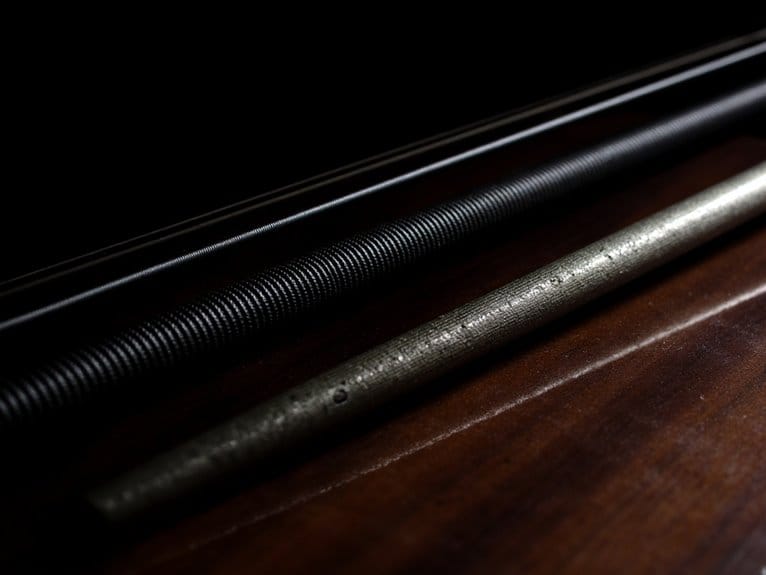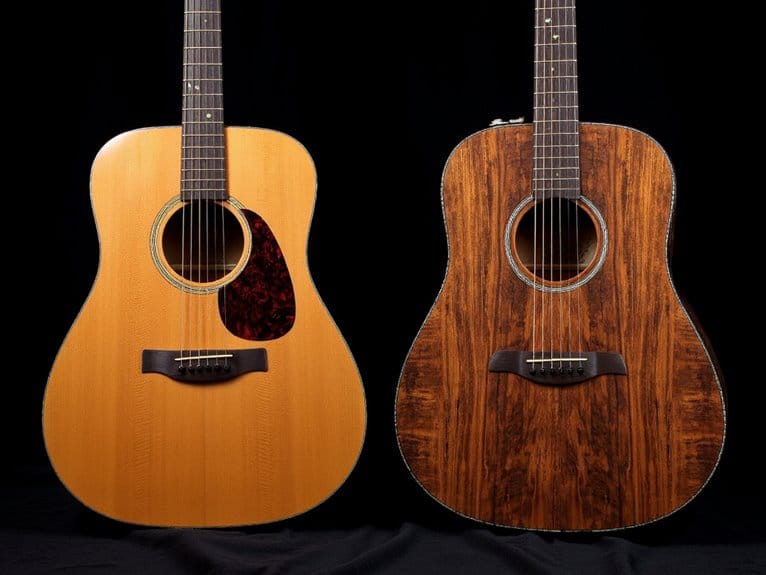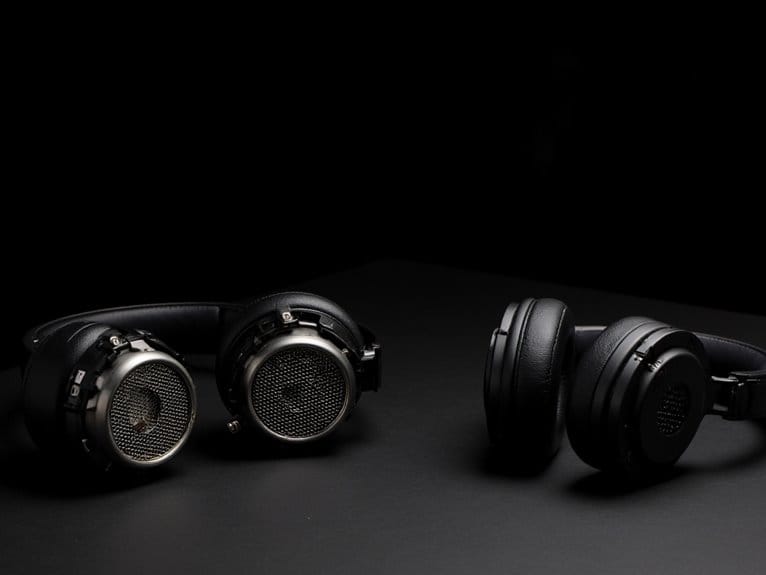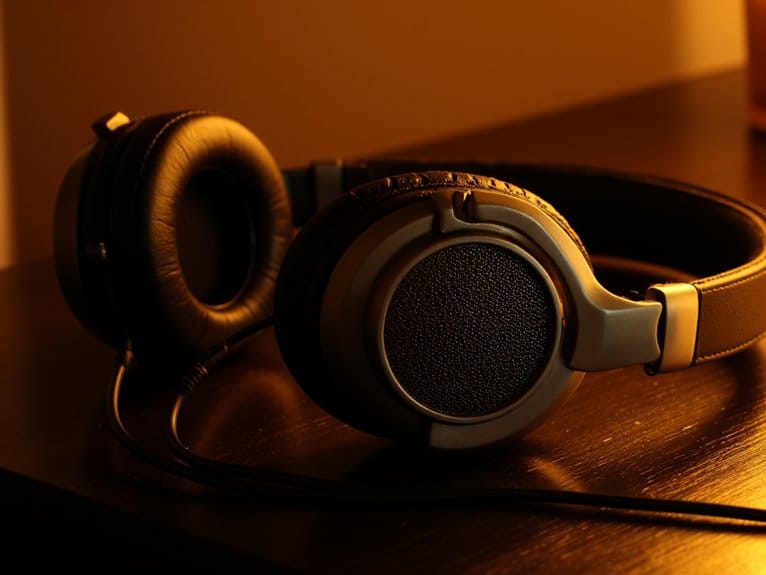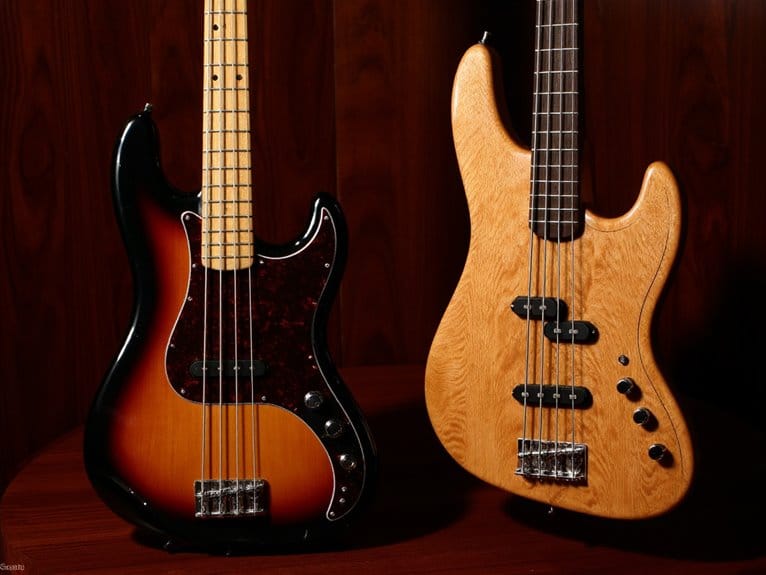Roundwound Vs Flatwound Bass Strings: Complete Guide
You’ll find roundwound bass strings deliver bright, harmonically-rich tones with pronounced upper frequencies that cut through rock and metal mixes, while flatwound strings produce warmer, mellower sounds emphasizing fundamental frequencies perfect for jazz and blues. Roundwounds feature spiral-wrapped round wire creating textured surfaces that provide tactile feedback but cause finger discomfort, whereas flatwounds use ribbon-like wire for smooth coverage that reduces friction and enhances comfort. Understanding these construction differences, along with their distinct durability characteristics and genre applications, helps you make informed decisions about your bass’s sonic personality.
We are supported by our audience. When you purchase through links on our site, we may earn an affiliate commission, at no extra cost for you. Learn more.
Notable Insights
- Roundwound strings deliver bright, harmonically-rich tones ideal for rock and funk, while flatwounds produce warmer, mellower sounds perfect for jazz.
- Roundwound construction uses spiral-wrapped round wire creating ridged surfaces, whereas flatwounds feature smooth ribbon-like wire for seamless coverage.
- Flatwound strings offer smoother playing feel with reduced friction, while roundwounds provide tactile feedback but may cause finger discomfort.
- Flatwounds cost more initially but last longer with less fret wear, while roundwounds are cheaper but require more frequent replacement.
- Recording setups and pickup configurations significantly influence how each string type interacts with your bass and overall sound production.
Sound Characteristics and Tonal Differences
When I first started playing bass seriously, the choice between roundwound and flatwound strings felt like choosing between two completely different instruments.
Honestly, the tonal differences are so dramatic that they can fundamentally reshape your entire sound and playing approach. The brightness differentiation between these strings is immediately apparent – roundwounds deliver that crisp, harmonically-rich tone with pronounced upper frequencies, while flatwounds produce a warmer, mellower sound that emphasizes fundamental frequencies over overtones.
You’ll notice roundwounds offer enhanced tonal richness through their complex harmonic content, creating that signature “growl” perfect for rock and slap techniques. Their ribbed texture also provides more grip under your fingers during aggressive playing styles. Flatwounds, conversely, provide a smoother, vintage character that mimics upright bass qualities, making them ideal for jazz applications where controlled warmth matters more than aggressive presence. Additionally, flatwound strings exhibit less sustain compared to their roundwound counterparts, which contributes to their punchy, controlled character.
Construction Methods and String Design
Understanding the fundamental construction differences between roundwound and flatwound strings requires examining the core wire and wrap wire materials that create their distinct characteristics, and I’ve found that most players don’t realize how greatly these manufacturing choices affect both playability and tone.
Both types use high-carbon steel cores for strength, but their winding techniques create entirely different playing experiences.
Roundwounds employ spiral wrapping of round wire, leaving gaps that form ridged surfaces, while flatwounds use ribbon-like wire wound tightly for smooth, gapless coverage. The ribbon wrap wire creates contact points around the entire circumference of the string, which naturally reduces brightness and sustain compared to roundwound construction.
The manufacturing precision required for flatwounds is considerably higher, as maintaining flat wire integrity without kinks demands careful control. Many affordable bass guitars under $200 come pre-strung with roundwound strings, making them the standard choice for most beginning players.
Halfwound strings represent a hybrid approach, beginning as roundwounds before grinding processes smooth their ridges. When amplified, these tonal differences become even more pronounced, which is why understanding compression ratios helps bassists manage the dynamic variations between string types during performance.
Playing Feel and Performance Impact
While construction differences between roundwound and flatwound strings might seem purely technical, I’ve discovered that these manufacturing variations translate into dramatically different playing experiences that can fundamentally alter your bass technique, musical expression, and overall comfort during extended sessions. Your fingers immediately notice the texture difference—roundwounds feel bumpy with tactile feedback that helps precise positioning, while flatwounds present a slick, smooth surface that reduces friction and finger soreness during long practice sessions.
| Feature | Roundwound | Flatwound |
|---|---|---|
| Surface Texture | Bumpy, ridged | Smooth, slippery |
| Playing Technique | Precise positioning | Fast slides, legato |
| Finger Comfort | Higher friction | Reduced soreness |
This playing technique adjustment affects your speed, vibrato control, and string bending responsiveness, making string choice essential for your musical style.
Durability, Lifespan, and Cost Considerations
Beyond their sonic and tactile differences, I’ve learned that the financial implications of string choice extend far beyond the initial purchase price, encompassing replacement frequency, maintenance requirements, and even the long-term health of your bass itself.
Flatwounds cost more upfront but last considerably longer due to their smooth construction, which resists dirt accumulation and corrosion better than roundwounds. You’ll find that durability factors like fret wear favor flatwounds, as their smoother surface causes less hardware damage over time.
While roundwounds require more frequent replacement and intensive maintenance practices, including regular cleaning to combat corrosion, flatwounds can reportedly last indefinitely with proper care, making them more economical long-term despite their higher initial investment. Some manufacturers have addressed durability concerns through cryogenic treatment, which can extend string lifespan twice that of conventional options. Just as some bass guitars feature active/passive switching that provides versatility and prevents mid-performance issues, choosing the right string type requires considering both immediate needs and long-term reliability.
Just as with quality cables that offer superior sound transmission and durability, investing in the right string type can provide better long-term value despite higher upfront costs.
Genre Applications and Musical Suitability
When it comes to genre applications, I’ve discovered that the relationship between string choice and musical style isn’t as rigid as many bassists assume, though certain patterns have emerged through decades of musical evolution that make perfect sense once you understand the tonal characteristics we’ve already explored.
Roundwounds dominate pop, rock, metal, and funk due to their bright, punchy presence that cuts through dense mixes, while flatwounds excel in jazz, reggae, and blues where warmth and smoothness take priority. Similar to how guitarists rely on tube amp simulation to achieve authentic blues tones with their overdrive pedals, bassists must consider how their string choice affects the fundamental character of their sound. This careful selection is paramount in genres like reggae, where subtleties in tone can significantly impact the overall feel of the music. The rich, muted tones of flatwound strings can beautifully enhance the elements of reggae bass artistry, allowing for a more laid-back and groove-oriented performance. Ultimately, the choice between roundwounds and flatwounds can shape not only the bassist’s sound but also the emotional landscape of the music being created.
However, genre preferences aren’t absolute rules – Steve Harris proves flatwounds can work brilliantly in metal, and many player experiences demonstrate that personal tone goals often override conventional wisdom when selecting strings for specific musical contexts. Understanding your recording setup is equally important, as interfaces with high-performing preamps can capture the nuanced differences between string types more effectively during studio sessions.
Just as with bass guitars themselves, the pickup configuration you’re using can significantly influence how different string types interact with your instrument’s electronics, making some combinations particularly effective for achieving your desired tonal output across various genres.
Frequently Asked Questions
Can I Mix Flatwound and Roundwound Strings on the Same Bass?
You can absolutely mix flatwound and roundwound strings on your bass. String compatibility isn’t an issue, though you’ll need proper setup adjustments. The tonal differences create unique sound combinations that many professional players use.
How Do I Adjust My Bass Setup When Switching String Types?
When switching string types, you’ll need to adjust your truss rod for proper neck relief, set bridge saddle string height appropriately, recalibrate intonation, and fine-tune pickup adjustment to match the new strings’ magnetic output characteristics.
How Long Should I Expect Each String Type to Last?
You’ll find string longevity varies markedly between types. Roundwounds typically last 1-3 months, while flatwounds can go 4-6 months or longer. Wear factors like playing frequency, sweat acidity, and maintenance habits affect both types’ lifespan considerably.
On a final note
You’ll need to contemplate your playing style, musical preferences, and budget when choosing between roundwound and flatwound strings. If you’re after bright, punchy tones with sustain, roundwounds are your best bet. For smooth, vintage warmth with easier fretting, flatwounds deliver consistently. Don’t overthink it—your ears and fingers will tell you what works best for your bass and musical goals.

